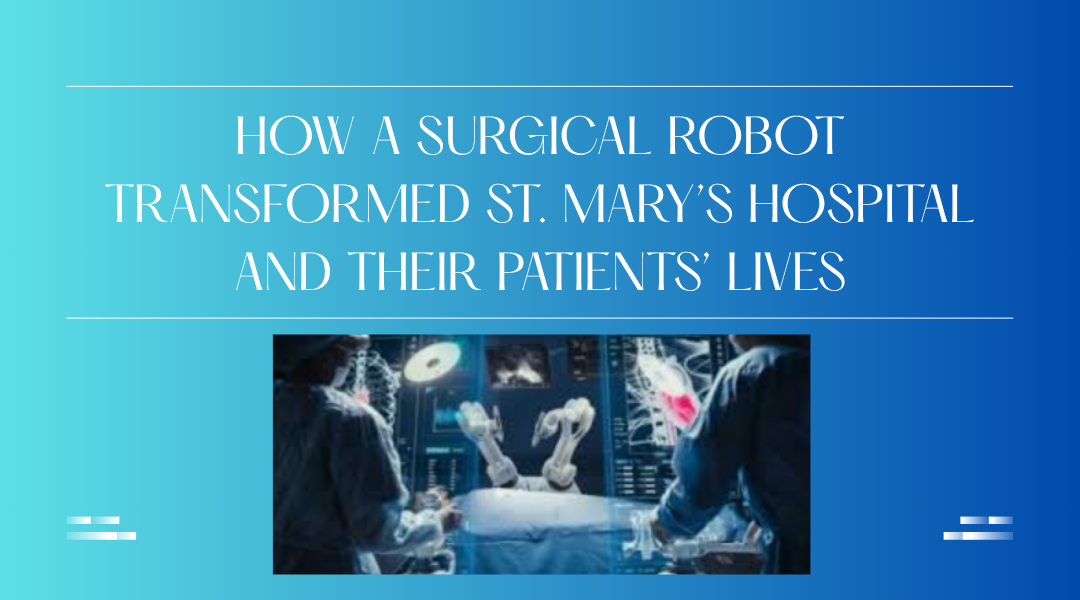Introduction
St. Mary’s Hospital had always been the place people turned to when other hospitals said a case was too complex. But even with skilled surgeons, certain procedures—like delicate heart operations or tumor removals—still came with grueling recoveries, high risks, and sleepless nights for patients and families. That all changed when the hospital brought in the Da Vinci Surgical System, a robotic assistant that turned invasive surgeries into minimally invasive miracles.
The Problem: High-Risk Surgeries, Slow Recoveries
Before the robot, surgeries at St. Mary’s followed the old playbook: large incisions, longer hospital stays, and a painful road to recovery.
- Risky Operations: Procedures near critical organs, like prostatectomies or cardiac repairs, left little room for error. One slip could mean complications for life.
- Patient Struggles: Weeks of downtime, higher infection risks, and emotional exhaustion took a toll. One patient, James Rivera, recalled, “I was terrified—not just of the surgery, but of being stuck in a hospital bed for weeks.”
The Game-Changer: A Robotic Helping Hand
The hospital’s leadership knew they needed a better way. After months of research, they secured funding (part grants, part donors) and brought in the Da Vinci system. But buying it was just the first step—surgeons had to learn it.
- Surgeon Boot Camp: Dr. Sarah Lin, a urologic oncologist, trained for months, mastering the robot’s 3D visualization and wrist-like instruments. “It’s like switching from open-heart surgery to keyhole precision,” she said.
- OR Overhaul: Nurses redesigned workflows—sterilizing robotic arms, positioning patients differently, and even adjusting anesthesia protocols for shorter procedures.
The First Big Win: John’s Story
John Davis, a 58-year-old teacher with prostate cancer, became the first patient to undergo robotic surgery at St. Mary’s.
- Pre-Op Prep: Scans created a 3D map of John’s anatomy, allowing Dr. Lin to rehearse the procedure digitally.
- Surgery Day: From her console, Dr. Lin guided the robot’s arms with movements steadier than human hands. The robot’s tiny instruments removed the tumor through incisions no larger than a fingertip.
- Recovery: John walked the next morning and was home in 48 hours. “I expected to be down for weeks,” he said. “Instead, I was back to grading papers in a week.”
Expanding the Revolution
Word spread fast. Soon, the robot was assisting in:
- Gynecology: Women with endometriosis avoided hysterectomies thanks to targeted robotic tissue removal.
- Cardiac Surgery: A retired Marine, Maria Gonzalez, had a mitral valve repair without a single broken rib—previously unheard of in open-heart cases.
The Real Impact: By the Numbers
- Complications dropped by 40% in robotic cases.
- Hospital stays shortened from 7 days to 2 for procedures like prostatectomies.
- Surgeons reported less fatigue—no more hunching over patients for hours.
Hurdles Along the Way
It wasn’t all smooth sailing.
- The Learning Curve: Early on, Dr. Lin admitted, “I missed the tactile feedback of holding a scalpel. It felt like operating with oven mitts at first.”
- Cost Questions: At $2 million, the system wasn’t cheap. But CFO Mark Reyes crunched the numbers: “Fewer readmissions and shorter stays actually saved us money long-term.”
Becoming a Regional Hub
St. Mary’s didn’t keep the tech quiet. They hosted public demos, letting locals try simulated robotic surgery (a hit with med students and curious kids). Local news covered John’s story, and soon, patients were driving hours for consultations.
What’s Next?
- Training the Next Generation: The hospital’s new robotics lab teaches surgeons from rural areas.
- Remote Surgeries: Trials are underway for telesurgery, where St. Mary’s specialists could guide robots in underserved towns.
The Bottom Line
St. Mary’s didn’t just adopt a robot—they redefined patient care. As Dr. Lin put it: “This isn’t about machines replacing surgeons. It’s about giving us better tools to do what we’ve always wanted: heal people with less pain and more hope.”
Why It Matters for Healthcare
Other hospitals are taking notes. In an era where patients demand faster recoveries and precision, robotics isn’t just flashy tech—it’s the future of compassionate medicine.
